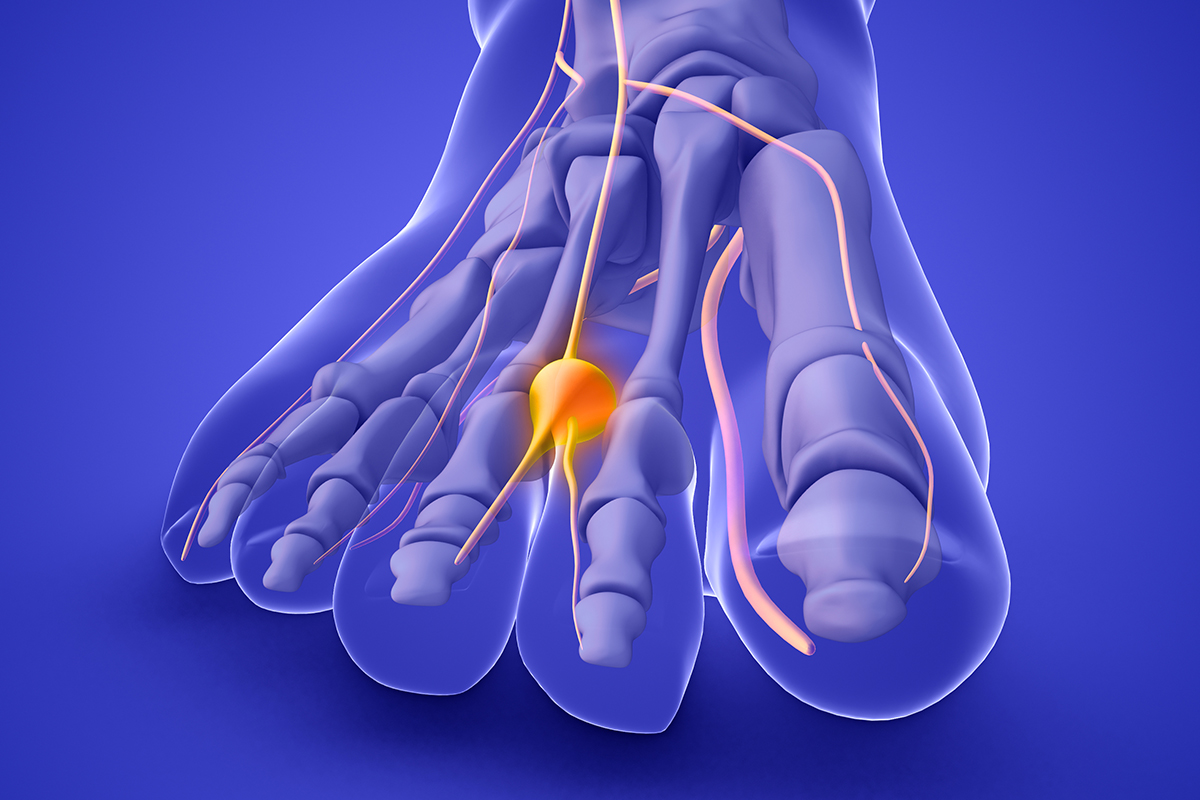Morton’s neuroma is a painful condition that affects the ball of the foot, most commonly between the third and fourth toes. It occurs when the tissue surrounding one of the nerves leading to the toes thickens, causing irritation and compression. This leads to discomfort, numbness, or a sensation of standing on a pebble. Morton’s neuroma is not a true tumor but rather a nerve entrapment condition that can worsen over time if left untreated.
What is Morton's Neuroma?

Causes and Risk Factors
Morton’s neuroma is often caused by repetitive stress or compression of the nerve between the metatarsal bones. Contributing factors include:
- Wearing tight, narrow, or high-heeled shoes that squeeze the toes
- Engaging in high-impact sports such as running or court sports
- Foot deformities like flat feet, high arches, or bunions
- Repetitive foot trauma leading to irritation and nerve thickening
- High impact activities like running can cause irritation and nerve thickening
Symptoms
Patients with Morton’s neuroma often describe symptoms such as:
- A sharp or burning pain in the ball of the foot, radiating to the toes
- A sensation of standing on a pebble, having a fold in the sock, or a lump between the toes
- Tingling or numbness in the affected toes
- Worsening pain when wearing tight shoes or walking for long periods
Diagnosis
A thorough clinical evaluation by a foot and ankle specialist is necessary for an accurate diagnosis. Diagnostic tools may include:
- Physical Examination: Palpation of the affected area to reproduce symptoms
- Mulder’s Sign: A squeezing test that often elicits a clicking sensation
- Imaging: X-rays to rule out bone abnormalities, ultrasound to detect nerve thickening, and MRI for a detailed assessment
Morton's Neuroma Treatment
Conservative Management
Non-surgical treatment options are often effective and include:
- Footwear Modifications: Wearing wider, cushioned shoes with low heels
- Orthotics and Padding: Custom insoles or metatarsal pads to relieve pressure on the nerve
- Activity Modifications: Reducing high-impact activities to prevent further irritation
- Medications: Nonsteroidal anti-inflammatory drugs (NSAIDs) for pain relief
- Injections: Corticosteroid or alcohol injections to reduce inflammation and pain
When is Surgery Required?
If conservative treatments fail to provide relief, surgical intervention may be necessary. The goal of surgery is to decompress or remove the affected nerve to alleviate pain.
- Nerve Decompression: Releasing the surrounding structures to relieve pressure on the nerve
- Neuroma Excision: Surgical removal of the thickened nerve to eliminate symptoms
- Nerve Implantation to Muscle Belly: In cases where neuroma excision is performed, implanting the severed nerve into a nearby muscle belly may help prevent painful nerve stump formation (neuroma recurrence / stump neuroma) and improve post-surgical outcomes.
- Minimally Invasive Techniques: Certain cases may benefit from small-incision procedures to reduce recovery time

Why Choose Us for Morton's Neuroma Care
Dr. Nicole Cates, a board-certified foot and ankle surgeon, specializes in diagnosing and treating Morton’s neuroma using both conservative approaches and advanced surgical techniques. For cases requiring surgical removal of the neuroma, Dr. Cates is trained in an advanced technique where the resected nerve is implanted into a muscle to prevent stump neuromas, significantly reducing the risk of recurrence and improving long-term outcomes. At Foot Surgery San Francisco, we create personalized treatment plans tailored to each patient’s needs, ensuring the best possible results. If you are experiencing persistent foot pain, schedule an appointment today for a comprehensive evaluation and expert care.
What is Tarsal Tunnel Syndrome?
Tarsal tunnel syndrome is a condition caused by compression of the posterior tibial nerve as it passes through the tarsal tunnel, a narrow space on the inside of the ankle. This nerve entrapment can lead to pain, tingling, numbness, or burning sensations in the foot and ankle. Tarsal tunnel syndrome is similar to carpal tunnel syndrome in the wrist but affects the lower extremity.
If left untreated, the condition can worsen over time, leading to chronic nerve damage and persistent discomfort. Early diagnosis and proper treatment are essential to prevent long-term complications.

Causes and Risk Factors
Tarsal tunnel syndrome occurs when increased pressure is placed on the posterior tibial nerve. Common causes and risk factors include:
- Flat feet or fallen arches: Can increase strain on the nerve due to excessive pronation.
- Ankle injuries: Sprains, fractures, or trauma can cause swelling and nerve compression.
- Systemic conditions: Diabetes and inflammatory diseases (such as arthritis) can predispose individuals to nerve compression.
- Ganglion cysts, lipomas, or varicose veins: Space-occupying lesions can press on the nerve.
- Tight shoes or improper footwear: Can contribute to compression and irritation of the nerve.
- Repetitive stress: Activities that put repeated pressure on the foot, such as running or standing for long periods, can exacerbate symptoms.
- Back problems: Spinal issues such as herniated discs or lumbar radiculopathy can contribute to nerve dysfunction.
- Double crush injury: Compression of nerves at multiple sites, such as both the lumbar spine and tarsal tunnel, can make the nerve more vulnerable to damage.
Symptoms
Symptoms of tarsal tunnel syndrome can vary in intensity and may worsen with activity. Common symptoms include:
- Burning, tingling, or numbness in the sole of the foot and toes.
- Sharp, shooting pain along the inside of the ankle or bottom of the foot.
- A feeling of electrical shocks or pins-and-needles sensations.
- Pain that worsens with prolonged standing, walking, or activity
- Weakness or muscle atrophy in severe or chronic cases.
Diagnosis
A thorough clinical evaluation by a foot and ankle specialist is necessary for an accurate diagnosis. Diagnostic tools may include:
- Physical Examination: Assess for tenderness along the tarsal tunnel and perform the Tinel’s sign test, where tapping over the nerve may reproduce tingling sensations.
- Imaging Tests: X-rays, ultrasound, or MRI scans may be used to identify underlying structural causes such as cysts, tumors, or bony abnormalities.
- Nerve Conduction Studies (EMG/NCS): These tests assess nerve function and help confirm the diagnosis.
- Treatment includes rest, anti-inflammatory medications, custom orthotics, and corticosteroid injections. In severe cases, surgery is performed to release the pressure on the nerve.
Tarsal Tunnel Syndrome Treatment
Conservative Management
Early treatment focuses on reducing nerve compression and inflammation. Non-surgical options include:
- Activity modification: Avoiding repetitive stress and prolonged standing can help alleviate symptoms.
- Orthotics and supportive footwear: Custom insoles or arch supports can help stabilize the foot and reduce pressure on the nerve.
- Bracing or ankle supports: Can provide additional stability and prevent excessive motion that exacerbates symptoms.
- Physical therapy: Stretching, strengthening exercises, and nerve glide techniques can improve mobility and reduce nerve irritation.
- Anti-inflammatory medications: NSAIDs (e.g., ibuprofen) or corticosteroid injections can help relieve pain and swelling.
- Platelet-rich plasma (PRP) injections: A regenerative therapy option that may help reduce nerve inflammation and promote healing.
When is Surgery Required?
Surgery is considered when conservative treatments fail to relieve symptoms. The goal of surgery is to decompress the posterior tibial nerve and restore normal function.
- Tarsal tunnel release: A surgical procedure where the ligament overlying the tarsal tunnel is carefully cut to relieve pressure on the nerve.
- Removal of space-occupying lesions: If a cyst, lipoma, or varicose vein is compressing the nerve, surgical excision may be necessary.
- Nerve wrapping or nerve implantation: In cases of chronic nerve damage, advanced techniques such as wrapping the nerve with a protective covering or implanting it into a muscle belly may be used to prevent further irritation and reduce pain

Why Choose Us for Tarsal Tunnel Syndrome Care?
Dr. Nicole Cates, a board-certified foot and ankle surgeon, offers specialized expertise in diagnosing and treating tarsal tunnel syndrome with a comprehensive approach. She employs the latest conservative therapies and, when necessary, advanced surgical techniques to relieve nerve compression and restore function. Dr. Cates is skilled in performing tarsal tunnel release to enhance recovery and minimize complications. At Foot Surgery San Francisco, we tailor treatment plans to each patient’s unique needs, ensuring the highest level of care. If you are struggling with foot pain, numbness, or tingling, contact us today for a thorough evaluation and personalized treatment options.

